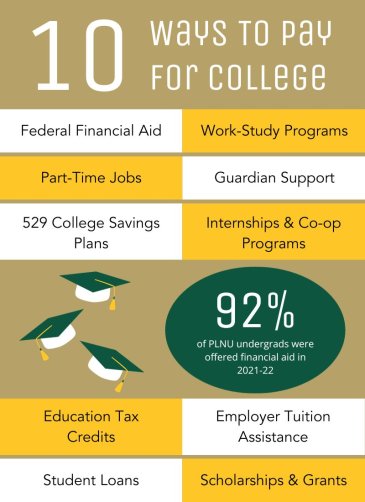
Embarking on the journey of higher education is an investment in yourself; however, the financial aspects of pursuing a college degree can be a daunting hurdle. With tuition costs on the rise, finding creative and effective ways to pay for college has become a pressing concern for students and their families.
In this comprehensive guide, we'll explore ten strategic approaches to help you navigate the financial landscape of higher education. From scholarships and grants to loans and work-study programs, we'll provide you with a diverse toolkit to ensure that the pursuit of knowledge doesn't come at an overwhelming financial burden.
Whether you're a prospective student, a concerned parent, or an eager guardian, this article will equip you with the knowledge to make higher education an attainable reality.
Strategic methods to fund your education
Paying for college is a significant financial commitment, but there are various ways to fund your education. Here are ten methods to consider:
Scholarships and grants
Apply for a variety of scholarships and grants offered by colleges, private organizations, and government agencies. A scholarship is financial aid that does not need to be repaid.
Scholarships are merit-based, which means they are offered based on merit or achievement in a specific area. You can receive scholarships through PLNU or apply for others online.

Federal financial aid
Determine your eligibility for Federal Financial Aid — the financial assistance provided by the federal U.S. government to help students and their families cover the costs of higher education. Grants and loans are examples of federal financial aid.
This aid is primarily disbursed through the U.S. Department of Education and is intended to make college or vocational training more accessible for eligible students.
How do I qualify for federal financial aid?
Fill out the free application for Federal Student Aid (FAFSA) to determine your eligibility for:
- Federal grants
- Work-study programs
- Subsidized and/or unsubsidized loans
This form assesses the financial needs of the student and their family to determine eligibility. Eligibility is based on elements like family income, assets, household size, and the number of family members in college, etc.
Work-study programs
Participate in a federal or state work-study program, where you work part-time on or off-campus to earn money for your education.
You may be wondering: what is a work-study program? A work-study program is a federally-funded initiative in the United States that provides part-time employment opportunities for eligible college and university students.
These programs are designed to help students earn money to cover a portion of their educational expenses — for example, tuition, fees, and living costs. Work-study positions are often located on campus or with approved off-campus nonprofit organizations or public agencies.
Learn more about work-study programs at PLNU.
Part-time jobs
A part-time job while in college can be a valuable way to gain work experience, develop time management skills, and earn money to help cover living expenses and educational costs.
Consider working part-time while attending college to help cover living expenses and some educational costs.
Internships and co-op programs
Consider paid internships or cooperative education programs related to your field of study, which can provide valuable experience and income.
What is an internship?
An internship is a temporary position with a company or organization, typically lasting for a few months, often during the summer or a semester. Internships can be paid or unpaid, and are not always directly related to a student's major.
The primary focus of an internship is on providing the intern with valuable work experience and exposure to a specific industry or profession.
What is a co-op program?
A co-op program is a more structured and formalized work experience—compared to an internship — often lasting for a longer duration, such as six months or even a full year.
Co-op programs are usually paid and are directly related to a student's major or field of study. Co-op programs are typically integrated into the student's academic curriculum, meaning that they alternate periods of work with periods of classroom study.
Both paid internships and co-op programs can be valuable in preparing students for their future careers and helping fund higher education.
529 College savings plans
Consider opening a 529 plan, which is a tax-advantaged savings account specifically designed to help families save for future educational expenses. In this type of account, contributions grow tax-free and withdrawals are tax-free when used for qualified education expenses.
These plans are named after Section 529 of the Internal Revenue Code, which created these savings plans in 1996, and are accepted by PLNU as a tuition payment method.
529 plans offer a flexible and powerful tool for parents, guardians, and even students themselves to invest funds set aside for higher education. Read more about 529 Plans on the IRS website, including advantages, contribution limits, and more.
Guardian support
If possible, discuss financial assistance with your parents or guardians. They may be able to contribute to your education costs. Even if you end up paying them back over time, they likely won't charge you interest!
Employer tuition assistance
Some companies offer programs to support employees pursuing higher education. Check if your employer offers employer tuition assistance, also known as employer-sponsored education or tuition reimbursement.
Under these programs, some employers provide financial support to cover a portion or the entirety of an employee's educational expenses, such as tuition, fees, and sometimes even books or course materials.
This support is typically contingent on the employee meeting certain criteria; for example, maintaining a minimum GPA or pursuing a degree relevant to their current job or future career within the company.
Well-known companies known for providing tuition assistance include Starbucks, Walmart, Amazon, and more. Read on to learn about each program:
- Starbucks’ College Achievement Plan
- Walmart’s Live Better U Program
- Amazon’s Career Choice Program
Education tax credits
Education tax credits are incentives provided by the government to help individuals and families offset the costs of higher education. These credits can reduce the amount of income tax owed, providing financial relief for those investing in education.
Research and take advantage of education tax credits like the American Opportunity Tax Credit (AOTC) or the Lifetime Learning Credit (LLC) to reduce your tax liability.
American Opportunity Tax Credit (AOTC)
The American Opportunity Tax Credit provides a tax benefit for qualified education expenses incurred during the first four years of post-secondary education. It can be claimed by eligible students and their parents or guardians. The maximum credit amount is $2,500 per eligible student per year.
Lifetime Learning Credit (LLC)
The Lifetime Learning Credit provides a tax credit for qualified tuition and related expenses paid for eligible students pursuing post-secondary education, including courses to acquire or improve job skills. The maximum credit amount is $2,000 per tax return.
Note that you cannot claim both the AOTC and the LLC for the same student in the same year. Eligibility criteria and qualifying expenses for these credits can vary, so please consult with a tax professional or refer to the IRS guidelines for the most up-to-date and accurate information.
Student loans
Consider federal student loans (subsidized and unsubsidized) with low-interest rates and flexible repayment options. Be cautious with private loans, which may have higher interest rates and less favorable terms, and always be sure to do your due diligence.
Keep in mind the following differences between subsidized and unsubsidized student loans.
Subsidized loans
Subsidized loans are need-based where the government covers the interest while the borrower is in school, during the grace period after graduation, and during deferment periods.
Unsubsidized loans
Unsubsidized loans are not need-based. Interest begins accruing as soon as the loan is disbursed and borrowers are responsible for all interest payments.
Investing in your future at PLNU
Although the financial preparation can be challenging, at PLNU we believe that investing in an education is one of the most meaningful purchases you can make.
That’s why our Office of Student Financial Services at PLNU works hard to make your education affordable through scholarship offerings, student employment opportunities, and access to grants, loans, and other resources. In fact, 92% of PLNU undergraduates were offered financial aid in the 2020-21 academic year!
Read on to learn more about our types of financial aid and about the short and long-term costs and benefits of a college degree.